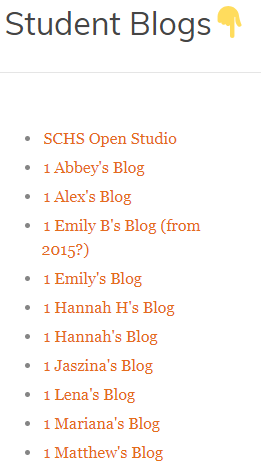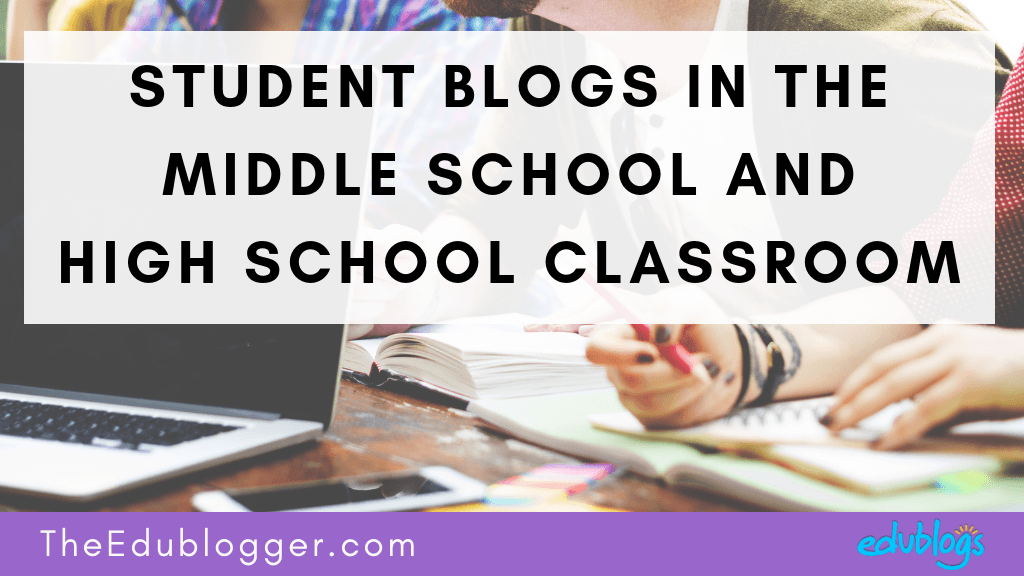A few weeks ago, we brought you the story of grade two teacher Becky Versteeg. She told us how she sets up student blogs with a new cohort of students.
Blogging offers many benefits for students from the early years of schooling right up to adult learners.
This week, we’re looking at how student blogs are used in a middle school and high school classroom.
Keith McCray explains how he uses blogs with his fifth grade students, while Heather Alexander tells us how blogging is incorporated into her year 9-12 ceramics classes.
The Middle School Classroom: Keith McCray
Keith is a fifth grade teacher in Maryland, USA. We asked him to tell us about the great work he’s doing with student blogs in his classroom.
 This is my second year incorporating student blogs into my daily lessons to provide the students with a truly authentic audience.
This is my second year incorporating student blogs into my daily lessons to provide the students with a truly authentic audience.
My students returned to school on September 4th. I cannot wait to begin to build relationships around the world and help my students take steps to become better writers.
I was so proud of my students last year; their growth was amazing. Students who typically scored a 2 on PARCC standardized test moved up to a 3 and those who typically scored a 3 moved up to 4! I cannot wait to see what this new group of students creates.
I like to slowly release the students to their own blogs by starting out on our class blog. This way, we can ensure that our blogging standards and commenting standards are met consistently.
I encourage my students to post any research that they have done, projects that they complete, and I absolutely LOVE the 100 Word Challenge! It requires students to be purposeful in their word choice to clearly convey their message.
In order to help build their audience, I take pictures of students working and post them (with emoji stickers over their faces) to Twitter with the hashtag “#comments4kids”.
Blogs are back @EasternWCPS! Ss practiced commenting today in prep to access their own blogs @edublogs and connect 🌎ly! Check out their goals at https://t.co/i014X8MLbe and cheer them on! #comments4kids #KidsDeserveIt #wcpsmd pic.twitter.com/dJZotVlGKl
— Keith McCray (@KMcCray85) September 6, 2018
The students work to really build their own audience as well. They use the class list from the Student Blogging Challenge and 100 Word Challenges to comment on other students’ work and they make sure to include links to their own blogs and encourage them to visit.
I am really looking forward to writing instruction this year! The incorporation of blogs, authentic audiences, and really pushing student interest projects makes it so much fun for my students that they do not even realize they are writing!
Visit Keith’s 5th Grade blog: http://mrmccraysclass.edublogs.org
Connect with Keith on Twitter: @KMcCray85
The Senior Classroom: Heather Alexander
Heather Alexander is a year 9-12 ceramics teacher in Florida. Heather kindly shared some insights into how her blogging program works.
 This is the third year students are blogging in ceramics class.
This is the third year students are blogging in ceramics class.
I started out having the students keep blogs as a place to reflect on their classwork when I stopped grading their art projects for a summative grade.
I shifted the focus from teacher-led projects to student choice, moving away from the technical and towards the personal. It allows for classroom grading at regular intervals but doesn’t require an artwork to be successful or to be completed by a certain point in the grading period.

Student usernames consist of their first name (last initial if needed) the class period, SC our school initials, and the two digits of their year of graduation. I include their class period as a leading numeral in their blog title so they can be snapped into order in the class listing.
The first year, I had the students set up their own account under my class account. It was my first year using Edublogs and I didn’t know what snags tended to happen. Since then, I’ve set up each student’s account working from a spreadsheet to keep track of URLs, passwords, and emails. I download a CSV file from our online gradebook and create a spreadsheet to copy and paste from when filling out the box to create student blogs.
This year I used the student’s county provided Outlook email address when creating the account. It is important that the students can submit the “forgot password” link and resolve their login problems on their own.
Presently, students blog three times a quarter using a class set of laptops for my room. I dream of having it a more fluid process, but for now, it works best to have them all blog once. I give a three-day window for the assignment. As a ceramics teacher, I am so thankful our brave media specialist allows me to have a cart in my classroom.
My advanced students have a rubric of twelve artistic behaviors and they select the appropriate prompts based on their current work.
In the level I classes, I have a handout prepared with four artistic behaviors as topics with 2-3 accompanying questions. Students select from two sets of questions to address in their post. I ask students to write nine sentences of analysis and include three images as a minimum. While I encourage them in conventions and spelling, I do not include it in the scoring of the blog.
My classes represent all the students that attend our school, from 9th to 12th grade: English language learners, exceptional education, and International Baccalaureate.
I still fall short in the area of encouraging an audience. They have peer blog mentor groups across the classes and comment on each other’s work. I have just learned how to pull a report on comments which makes it much easier to double check participation.
I still run into unhappy problems with comments getting hung up in each individual account’s spam filter. This is another problem that might be resolved if the commenting was authentic instead of assigned.
(Note: the above issue is due to students submitting comments at the same time and the Askimet spam fighting service detecting the comments as coming from the same IP address and marking them as spam.
Akismet learns from what is marked as spam and what is marked as not spam. Quickly marking the comment as not spam stops the comments from being spammed in future. Learn more.)
I still haven’t achieved the next level where students participate without checking “how many points is this worth?”.
Visit the SCHS Open Studio blog: http://missaclay.edublogs.org
Connect with Heather on Twitter: @MissAclay
Follow SCHS Open Studio on Instagram: @M17_open_studio
Conclusion
As you can tell, Keith and Heather didn’t have everything figured out from day one and their blogging programs are still evolving. There’s no right or wrong way to blog with students. The benefits are realized throughout the journey, not just through an end product.
If you’re interested in setting up students blogs, don’t let a fear of not knowing enough hold you back.
There’s lots of help out there:
- The Student Blogging Challenge begins on October 7, 2018. Find out more about registering.
- We have a self-paced Student Blogging Bootcamp you can assign your students. It will walk them through the process of setting up their blog.
- You can email the Edublogs support team at any time.
- You might also like to find a fellow teacher to work with. Either someone in our own school, or someone who’s part of your PLN.
Leave a comment if you have any questions or tips to share!





This blog is great! I really like that it has ideas for the middle school and high school level. I teach special education and have taught high school and I am currently at the middle school level. This blog has given great ideas to do with my current students for my small group math class. Below is my link for my blog I am just starting out with. I am doing a test run for my master’s course and want to include blogging with my students so I am testing it out myself first!
https://btkach77.edublogs.org/
Hey Benjamin,
Great work giving blogging a go now. I hope it works out well with your students and good luck with your studies!
Nice our class had it too 🙂
I really like your idea of the 100-word challenge. That is a great way for students to write enough as well as focusing on their word choice and their overall message. I also really liked how she incorporated blogs in a fine art class. That is cool because usually the fine arts do not do a lot of creative writing and explaining their artwork.
Thank you Ms.Arbee for adding me.